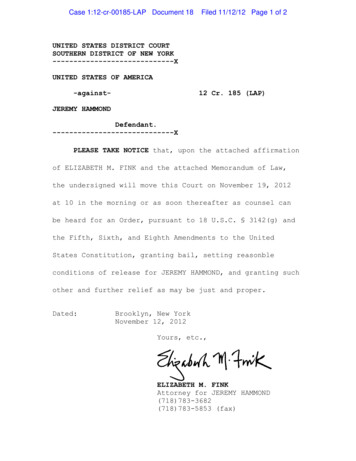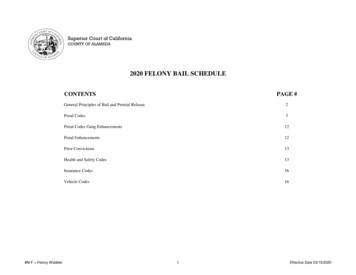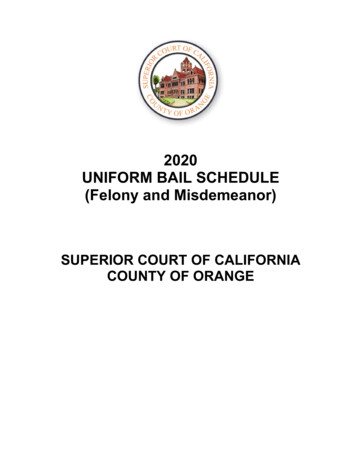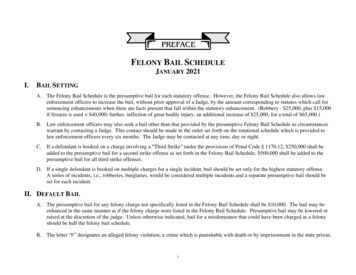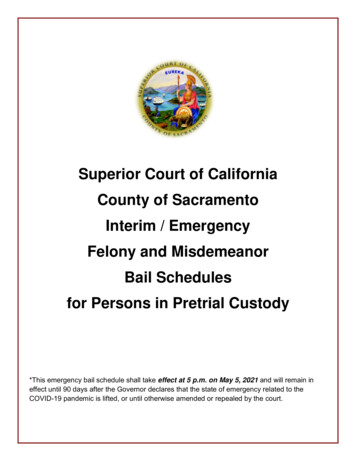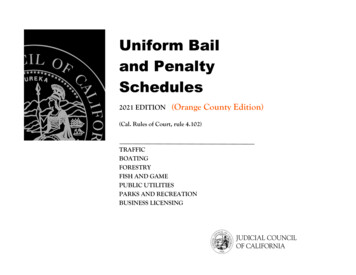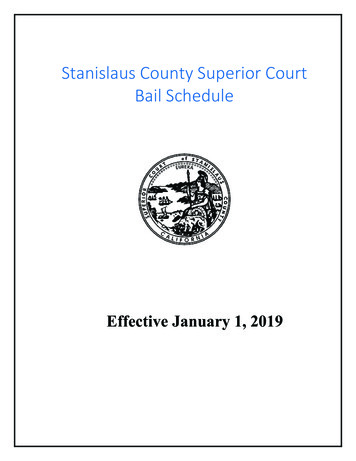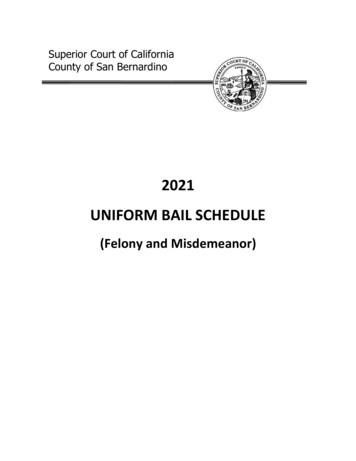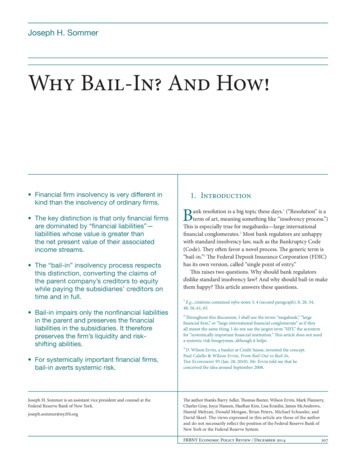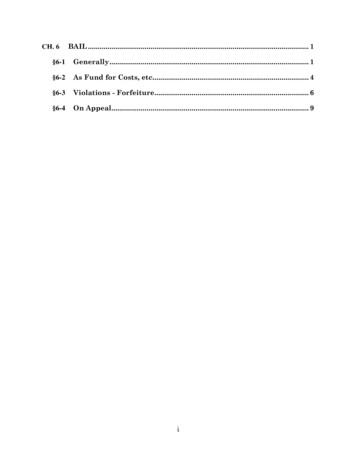
Transcription
BAIL . 1§6-1Generally . 1§6-2As Fund for Costs, etc. 4§6-3Violations - Forfeiture. 6§6-4On Appeal. 9i
BAIL§6-1GenerallyUnited States Supreme CourtU.S. v. Salerno, 481 U.S. 739, 107 S.Ct. 2095, 95 L.Ed.2d 697 (1987) The Court upheld bailact, which allowed pretrial detention of defendant charged with certain felonies wheredefendant poses a threat to the safety of individuals or the community.Schall v. Martin, 467 U.S. 253, 104 S.Ct. 2403, 81 L.Ed.2d 207 (1984) State statute allowingpre-trial detention of juveniles upon a finding of a “serious risk” that the juvenile may commita crime upheld.Stack v. Boyle, 342 U.S. 1, 72 S.Ct. 1, 96 L.Ed. 3 (1951) The traditional right to pre-trialbail:permits the unhampered preparation of a defense, and serves to prevent theinfliction of punishment prior to conviction. Unless this right to bail before trialis preserved, the presumption of innocence, secured only after centuries ofstruggle, would lose its meaning. Bail set at a figure higher than an amountreasonably calculated to [assure the presence of an accused] is ‘excessive' underthe Eighth Amendment . . . To infer from the fact of indictment alone a needfor bail in an unusually high amount is an arbitrary act.Other Federal CourtMeechaicum v. Fountain, 696 F.2d 790 (10th Cir. 1983) (and cases cited therein) TheEighth Amendment’s excessive bail provision is binding upon the states under theFourteenth Amendment.Illinois Supreme CourtPeople v. Bailey, 167 Ill.2d 210, 657 N.E.2d 953 (1995) The “no-bail” provisions of thestalking and aggravated stalking statutes allowing the trial court to deny bail where “theproof is evident or the presumption great” that defendant was guilty, defendant presented a“real and present threat” to the victim's physical safety, and denial of bail was necessary toassure the victim's safety, do not violate the Illinois Constitution.People ex rel. Hemingway v. Elrod, 60 Ill.2d 74, 322 N.E.2d 837 (1975) The right to bailbefore conviction is qualified by the inherent authority of the courts "as an incident of theirpower to manage the conduct of proceedings before them, to deny or revoke bail when suchaction is appropriate to preserve the orderly process of criminal procedure." However, denialor revocation of bail may not be based on mere suspicion, "but must be supported by sufficientevidence to show that it is required." Under the inherent power to manage the proceedings,courts may in appropriate circumstances keep an accused in custody pending trial "to preventinterference with witnesses or jurors or to prevent the fulfillment of threats." See also, Peoplev. Ealy, 49 Ill.App.3d 922, 365 N.E.2d 149 (1st Dist. 1977).People ex rel. Morrison v. Sielaff, 58 Ill.2d 91, 316 N.E.2d 769 (1974) A defendant is not1
entitled to sentence credit for time on bail.People v. Harris, 38 Ill.2d 552, 232 N.E.2d 721 (1967) An order denying bail may only bereviewed prior to conviction.People ex rel. Sammons v. Snow, 340 Ill. 464, 173 N.E. 8 (1930) A bail is excessive whereits only purpose is to keep defendant confined.Illinois Appellate CourtPeople v. Patton, 2020 IL App (2d) 190488Trial court erred in dismissing indictmentson the basis that it had set defendant’s bail at an excessive amount. The trial judgespecifically acknowledged that he had set defendant’s bail high solely for the purpose ofkeeping him in custody, which violated the Eighth Amendment according to People ex relSammons v. Snow, 340 Ill. 464 (1930). The judge concluded that the only reasonable remedywas to dismiss the charges.On appeal, the State argued that even if defendant suffered a due process violationdue to the excessive bail, dismissal of the indictment was the wrong remedy. The AppellateCourt agreed. Defendant needed to establish actual and substantial prejudice to warrantrelief. In the context of an excessive bail claim, that would require defendant to show thathad a lower bond been set, he could have posted it and gained release. Here, however, therecord established both that defendant would not have been able to post bail, and he hadoutstanding warrants and holds in other counties, so he would not have been entitled torelease.Even if defendant had established prejudice, dismissal of the indictment was an abuseof discretion. Instead, defendant should have availed himself of the review process underRule 604(c)(1).People v. Gil, 2019 IL App (1st) 192419 A court has discretion to deny bail undercircumstances as set forth in 725 ILCS 5/110-4(a). And, the procedures and requirements fordenying bail in non-probationable felony cases are set forth in 725 ILCS 5/110-6.1. Here, thecourt erred in denying bail without the filing of a verified petition and without making thespecific finding required by Section 110-6.1. Accordingly, the no-bail order was reversed andthe matter was remanded to the circuit court for determining monetary bond and otherconditions of release on bail.People v. Johnson, 2019 IL App (3d) 190582 Over a dissent, the Appellate Court affirmedthe denial of defendant’s motion to reduce his 2 million bond. Although the legislaturerecently amended the bail provisions of the Code of Criminal Procedure in order to shift thefocus of bail decisions from the wealth of the accused to the threat to safety and the risk offailure to appear, the court here considered appropriate factors when arriving at the 2million figure, including the seriousness of the offenses (possessing nearly 300 grams ofheroin with intent to deliver), the likelihood of conviction, and defendant’s criminal history.The dissent would have found that a 2 million bond is a functional denial of bond incontravention of the clear intent of the legislature, which recently passed section 110-5(a-5),wherein the legislature mandated a “presumption that any conditions of release imposedshall be non-monetary in nature and the court shall impose the least restrictive conditions”to ensure defendant’s appearance.2
People v. Simmons, 2019 IL App (1st) 191253 Appeals from the denial of bail are governedby Illinois Supreme Court Rule 604(c). Under Rule 604(c), the appeal is made by motion,supported by specific items listed in the rule, as well as a limited record. Here, defendantfailed to include some of the supporting material, specifically his financial condition,residence information, and employment history. The Appellate Court concluded that thesedeficiencies were not so serious as to warrant dismissal of the appeal and went on to considerthe merits of defendant’s motion for review.As a matter of first impression, the Appellate Court determined that thedecision to deny bail is reviewed for an abuse of discretion. Here, the court did notabuse its discretion where defendant was facing a 21-year minimum sentence for anarmed robbery charge on which there appeared to be strong evidence, includingdefendant’s own inculpatory statement. The Court also noted that defendant had acriminal history, and that while there were some factors to support the granting ofbail, the decision to deny bail was not arbitrary, fanciful, or unreasonable.People v. Williams (Edwards), 2012 IL App (2d) 111157 (No. 2-11-1157, 7/25/12) Under725 ILCS 5/110-7(a), a person who posts bail for a criminal defendant must receive writtennotice that the bail may be used to pay costs, fees, fines, attorney’s fees, or restitution, andthat all or part of the deposit may be lost or forfeited. The written notice must bedistinguishable from the surrounding text, in bold type or underscored, and in a type sizethat is at least two points larger than the surrounding type. (725 ILCS 5/110-7(a)).§110-7(a) creates a mandatory requirement concerning the notice to be given to aperson who posts bail, but even a mandatory provision may be satisfied by substantialcompliance where: (1) the purpose of the statute was achieved despite the absence of strictcompliance, and (2) the petitioner suffered no prejudice from the lack of strict compliance.Here, the petitioner posted 50,000 bond for a relative. The text of the written noticeprovided to the petitioner contained the statutory warnings in a “boxed-off” area on thebottom left corner of the page. Although the notice did not strictly comply with §110-7(a)because there were other bolded words on the page and the type was not two points largerthan the surrounding text, the court concluded that the two-part test set out above wassatisfied. Thus, the notice complied with §110-7(a).First, the purpose of §110-7(a) is to place third persons on notice that they may losemoney which they post as bond for criminal defendants. This purpose was served where thenotice section of the form was “boxed-off” in a corner of the page, the bolded heading in thebox stated: “NOTICE TO PERSON PROVIDING BAIL BOND OTHER THAN THEDEFENDANT,” and the box contained a warning that the bond could be used for costs, fees,or restitution. The notice also stated that the deposit could be forfeited. Any variations fromthe form required by §110-7(a) were de minimis and did not prevent the petitioner from beingplaced on notice that his bond deposit might not be returned.Next, the court concluded that the petitioner was not prejudiced by the failure tostrictly comply with the statute. The record showed that the petitioner posted bond becausehe believed the defendant to be innocent, not because he was unaware of the possibledrawbacks of posting bond. Also, the petitioner was present at a hearing when the possibilitythat the money would not be returned was discussed. Having received actual notice that hismoney might not be returned, the petitioner cannot claim to have been prejudiced by thefailure of the form to strictly comply with statute requirements.The court affirmed the trial court’s order applying the 50,000 bail bond to restitution.3
People v. Maldonado, 402 Ill.App.3d 411, 930 N.E.2d 1104 (1st Dist. 2010) Under 725 ILCS5/110-14, a defendant is entitled to a credit against a “fine” for each day of pretrialincarceration on a “bailable” offense. Under Illinois law, all offenses are “bailable” except forcertain offenses specified in 725 ILCS 5/110-4.As it applies to this case, §110-4 prohibits bail if the “proof is evident or thepresumption great that the defendant is guilty of the offense” and the offense is either: (1) acapital offense, or (2) a felony offense for which conditional release is not authorized. For thelatter class of offenses, the State must also establish in a hearing that release of thedefendant would pose a real and present threat to the physical safety of one or moreindividuals.Because the defendant was granted bail in the trial court, it was clear that the Statefailed to satisfy its burden to show that the offense was non-bailable. Because the offense wasbailable, defendant was entitled to credit against his fines.Lampe v. Ascher, 59 Ill.App.3d 755, 376 N.E.2d 74 (4th Dist. 1978) A police departmentdoes not have discretion to refuse tendered bail. The police are required to accept tenderedbail set either by a judge or a Supreme Court Rule.Gende v. Flemming, 55 Ill.App.3d 659, 371 N.E.2d 191 (3d Dist. 1977) A circuit clerk is notliable as a garnishee in regard to money held as bail bond from a judgment debtor.§6-2As Fund for Costs, etc.United States Supreme CourtSchilb v. Kuebel, 404 U.S. 357, 92 S.Ct. 479, 30 L.Ed.2d 502 (1971) The Court upheldIllinois statute allowing clerk to retain 10% of bail deposit (affirming Schilb v. Kuebel, 46Ill.2d 538, 264 N.E.2d 377 (1970)). See also, Andrews v. Danaher, 62 Ill.2d 268, 342 N.E.2d49 (1976).Illinois Supreme CourtPeople v. Love, 177 Ill. 2d 550, 687 N.E.2d 32 (1997) 725 ILCS 5/113-3.1 requires the trialcourt to conduct a hearing into defendant's financial circumstances and find an ability to paybefore it may order defendant to pay reimbursement for appointed counsel, even where acash bail bond has been posted on defendant's behalf. See also, People v. Webb, 276 Ill.App.3d570, 658 N.E.2d 852(3d Dist. 1995).People v. Dale, 112 Ill.2d 460, 493 N.E.2d 1060 (1986) Bail is first subject to fines and courtcosts, not attorney fees, even if defendant assigns the right to the bail deposit to his attorney.People v. Lange, 102 Ill.2d 225, 464 N.E.2d 1071 (1984) A court clerk may not retain 10%of the original bond posted, but only 10% of the amount on deposit when the criminalproceeding is finally concluded. Thus, where the original bond was 100,000 but bond wasreduced to 10,000 pending appeal, the clerk was entitled to retain only 10% of the 1,000posted on the 10,000 bond.People v. Castile, 87 Ill.2d 73, 429 N.E.2d 495 (1981) Costs taxed by a trial court may beordered paid from a bail deposit in the custody of the clerk of the appellate court. See also,4
People v. Crete, 133 Ill.App.3d 24, 478 N.E.2d 846 (2d Dist. 1985).County of Champaign v. Anthony, 64 Ill.2d 532, 356 N.E.2d 561 (1976) When defendantwas released on bail, the county placed an around-the-clock guard on the complaining witnessto protect her from injury. After defendant was convicted, the county filed a complaint againsthim seeking to recover the cost of providing the guard. The trial court dismissed thecomplaint, and the Supreme Court affirmed. Article 1, §9 of the Illinois Constitution prohibitsthe administrative imposition of a financial obligation upon a defendant in addition to theconditions fixed by the court in admitting him to bail. "The defendant's constitutional right(to bail) would be diluted if not nullified if he could be subjected, at th
the denial of defendant’s motion to reduce his 2 million bond. Although the legislature recently amended the bail provisions of the Code of Criminal Procedure in order to shift the focus of bail decisions from the wealth of the accused to the threat to safety and the risk of
